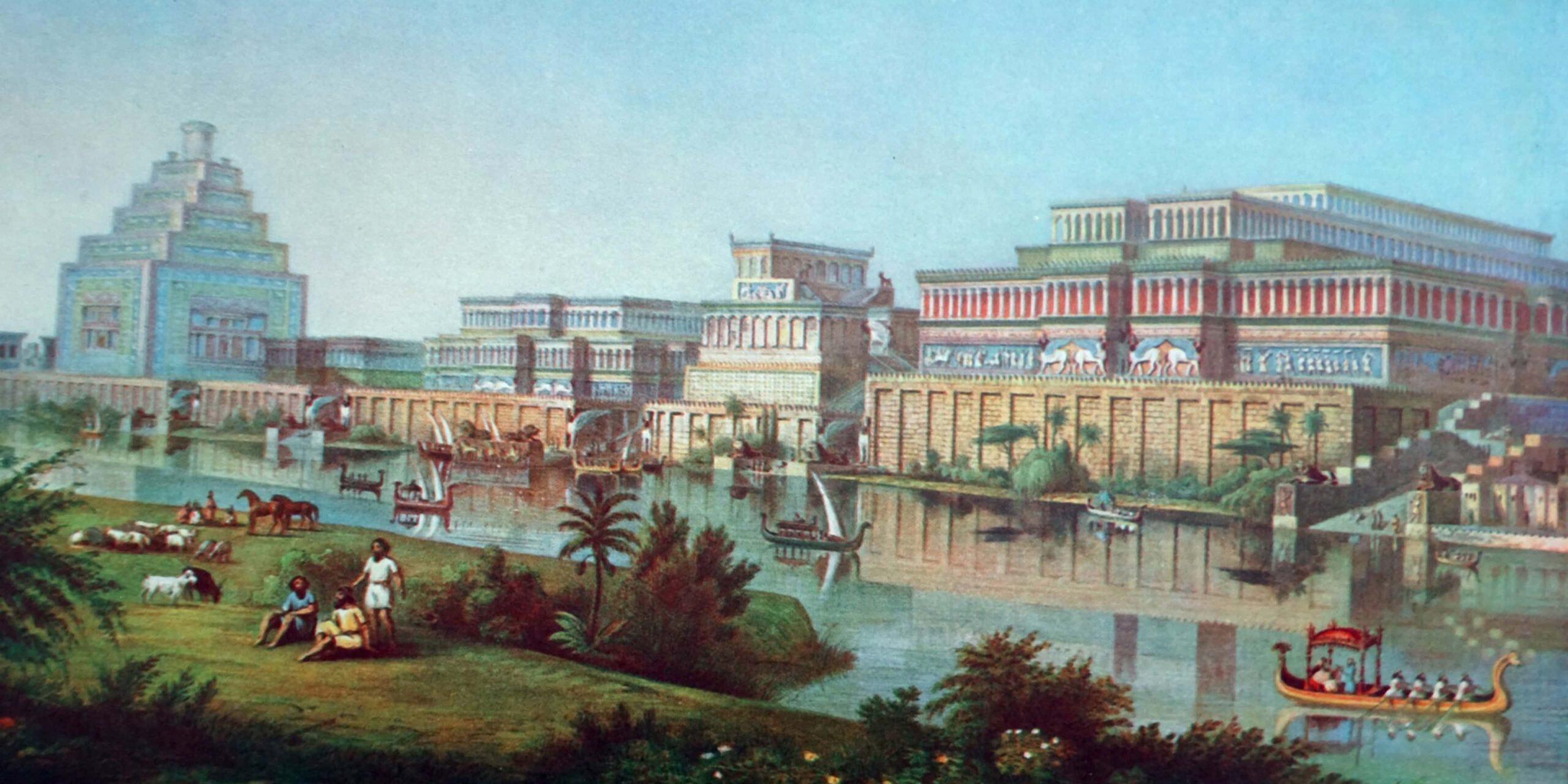
The History of Ancient Mesopotamia and Its Influence on Modern Society
Introduction: The Cradle of Civilization
Mesopotamia, often hailed as the “cradle of civilization,” occupies a pivotal position in human history. Situated in the fertile crescent of the Middle East, encompassing modern-day Iraq, Kuwait, and parts of Syria, Turkey, and Iran, this region flourished between the Tigris and Euphrates rivers. The very name “Mesopotamia” is derived from Greek, meaning “between the rivers,” a testament to its geographical defining characteristic. This ancient civilization’s enduring legacy profoundly shaped the trajectory of human development, and its influence resonates deeply within our modern society. Its contributions to writing, law, governance, science, technology, and literature laid the groundwork for many aspects of modern life, a legacy that continues to inspire and inform us today.
This exploration delves into the rich tapestry of Mesopotamian history, examining its key periods, significant achievements, and the enduring impact it has had on the world. From the pioneering Sumerians to the mighty empires of Akkad, Babylon, and Assyria, we will uncover the innovations, challenges, and cultural richness that defined this remarkable civilization.
The Dawn of Sumer: Foundations of Civilization (c. 4500-2334 BCE)
The Sumerian civilization, emerging around 4500 BCE, marks a watershed moment in human history. Its development represents a transition from scattered, nomadic settlements to complex, urban societies. This period witnessed unprecedented advancements across numerous domains, laying the foundations for subsequent civilizations and impacting our world in profound ways.
One of the most significant Sumerian contributions was the invention of cuneiform writing. This system, utilizing wedge-shaped marks impressed on clay tablets, revolutionized communication and record-keeping. Cuneiform enabled the Sumerians to document laws, administrative matters, economic transactions, literature, and religious beliefs, leaving behind a treasure trove of historical information. The ability to record and transmit knowledge facilitated the development of complex social structures and institutions, a hallmark of civilization.
The Sumerians were also masterful builders, constructing impressive cities like Uruk, Ur, and Nippur. These cities featured monumental architecture, including ziggurats—massive stepped pyramids dedicated to their gods—which served as religious and administrative centers. Advanced irrigation systems were crucial to their agricultural success, enabling the cultivation of crops and supporting a growing population. The development of sophisticated irrigation techniques demonstrates their engineering prowess and understanding of water management, skills that continue to be essential for agricultural productivity in modern times.
Beyond architecture and irrigation, the Sumerians also made significant contributions to mathematics and astronomy. Their development of a sexagesimal (base-60) number system—still evident today in our measurements of time (60 seconds in a minute, 60 minutes in an hour) and angles (360 degrees in a circle)—highlights their advanced mathematical understanding. Their observations of celestial bodies laid the groundwork for future advancements in astronomy.
The Sumerian social structure was hierarchical, with priests, rulers, and a complex network of officials managing the affairs of the city-states. This system, though rudimentary compared to later forms of government, established the essential elements of organized governance. The Sumerians’ experience with city-state organization, inter-city conflicts, and attempts at unification provides valuable insights into the challenges and complexities of early political systems.
The Rise of Empires: Akkad, Babylon, and Assyria
The Sumerian city-states eventually gave way to larger, more centralized empires. Sargon of Akkad, in 2334 BCE, unified Mesopotamia under his rule, creating the first true empire in the region. The Akkadian Empire brought about a period of political consolidation and expansion, establishing a centralized administration and military power. This period showcased the potential for large-scale imperial organization and the challenges inherent in maintaining such vast territories.
The Akkadian Empire’s dominance was followed by a succession of powerful kingdoms and empires. The Third Dynasty of Ur (c. 2112-2004 BCE) briefly restored Sumerian influence, characterized by its impressive administrative and economic organization. However, the rise of Babylon and Assyria would ultimately dominate the Mesopotamian landscape.
The Babylonian Empire, especially under Hammurabi (c. 1792-1750 BCE), achieved significant cultural and political influence. Hammurabi’s Code, one of the earliest known written legal codes, stands as a testament to their systematic approach to law and order. This code, while harsh by modern standards, established a framework for legal principles and procedures, demonstrating a sophisticated understanding of justice and societal governance. The influence of Hammurabi’s Code on later legal systems is undeniable, serving as an early example of codified law and its impact on societal order.
The Assyrian Empire (c. 2500-612 BCE) was known for its formidable military might and extensive territorial control. The Assyrians were masterful conquerors, developing sophisticated military strategies and weaponry. Their administrative prowess in managing a vast empire, including its intricate systems of taxation and control, demonstrated their organizational capabilities. Although their reign was often characterized by harsh rule and brutality, their contributions to warfare and imperial administration left a lasting mark on military and political thought.
Mesopotamian Science and Technology: Innovation and Practicality
Mesopotamian advancements extended beyond governance and administration. The region served as a hotbed of scientific and technological innovation, with their practical inventions significantly impacting daily life and shaping the future.
The invention of the wheel around 3500 BCE revolutionized transportation and trade, enabling the movement of goods and people over greater distances. This seemingly simple invention facilitated economic growth, cultural exchange, and the expansion of trade networks, impacting the growth and development of cities and empires.
The development of advanced agricultural techniques, including irrigation systems, crop rotation, and fertilization, enabled the region to support a large population and specialized labor. These advancements improved agricultural productivity, freeing up a portion of the population for activities outside agriculture, leading to greater societal complexity and specialization.
Mesopotamian mathematics was highly advanced, particularly their sexagesimal number system. This system, with its base of 60, impacted our timekeeping and angular measurement systems, showcasing their understanding of mathematical principles and their ability to apply them practically. Their advancements in mathematics also aided their astronomical observations and engineering feats.
Their astronomical knowledge, accumulated through meticulous observation and record-keeping, allowed for the development of sophisticated calendars and the prediction of celestial events. This knowledge not only influenced religious practices but also had practical implications for agriculture and navigation.
Cultural and Literary Legacy: Stories from the Ancient World
Mesopotamia boasts a vibrant cultural and literary legacy, leaving behind a rich tapestry of stories, poems, myths, and hymns. The Epic of Gilgamesh, dating back to around 2100 BCE, stands as one of the oldest surviving works of literature. This epic poem, recounting the adventures of the legendary king Gilgamesh, explores themes of mortality, friendship, and the human condition. Its influence on subsequent literature and mythology is undeniable, highlighting the enduring power of storytelling and the exploration of universal human themes.
Other notable literary works, including hymns to deities and lamentations reflecting societal experiences, provide valuable insights into Mesopotamian beliefs, values, and daily life. The works of Enheduanna, a female priestess and poet, highlight the role of women in Mesopotamian society, although their influence and societal roles were far from equal to those of men.
Mesopotamian mythology, characterized by a pantheon of gods and goddesses with distinct roles and attributes, played a significant role in shaping their worldview and social structures. The stories of these deities, their interactions, and their influence on human affairs, provide a fascinating glimpse into their religious beliefs and cosmological understanding. The intertwining of mythology, religious practice, and daily life demonstrates the profound impact of religion on Mesopotamian society and its cultural identity.
Mesopotamia’s Enduring Impact on Modern Society
The Mesopotamian civilization’s contributions continue to resonate profoundly in modern society. Its impact is visible across various aspects of our lives, underscoring the civilization’s remarkable and far-reaching influence.
The development of cuneiform writing laid the foundation for modern writing systems and literacy. The ability to record and transmit information facilitated the development of complex social structures, economic systems, and legal frameworks. Mesopotamian legal concepts, despite their differences from modern legal systems, introduced fundamental principles of codified law and due process.
The Mesopotamian system of governance, with its complex hierarchies and bureaucratic structures, influenced the development of modern state systems. Their advancements in irrigation and agricultural techniques continue to inform modern agricultural practices. Their sexagesimal number system remains deeply embedded in our measurement of time and angles, a testament to their mathematical insights.
The Epic of Gilgamesh and other Mesopotamian literary works continue to inspire artists and writers, demonstrating the lasting power of their storytelling and the enduring appeal of their exploration of fundamental human themes. Mesopotamian mythology, with its rich narratives and compelling characters, continues to inspire modern art, literature, and even film, demonstrating the lasting cultural impact of their rich mythological traditions.
The study of Mesopotamia is a multidisciplinary endeavor drawing upon archaeology, history, linguistics, anthropology, and other fields. This interdisciplinary approach underscores the complexity of ancient civilizations and the richness of the historical evidence available for study. By examining the artifacts, texts, and physical remains of this ancient civilization, we can gain deeper insights into the origins of human civilization, the development of complex societies, and the evolution of key aspects of human life.
The challenges faced by the Mesopotamians—environmental pressures, inter-city conflicts, and the rise and fall of empires—offer valuable lessons for understanding the complexities of human societies and the dynamics of historical change. Their innovations in governance, agriculture, and technology offer profound insights into human ingenuity and adaptability. Their artistic and literary achievements reflect their creativity and artistic expression, showcasing a vibrant cultural heritage that continues to inspire us today.
In conclusion, the history of Mesopotamia serves as a compelling narrative of human ingenuity, resilience, and creativity. From the humble beginnings of the Sumerian civilization to the rise and fall of powerful empires, Mesopotamia’s story reflects the complexities of early civilizations and their enduring impact on the world. Their innovations in writing, law, governance, science, technology, and the arts have profoundly influenced modern society, offering invaluable insights into the evolution of human civilization and the enduring legacy of a remarkable ancient world. The study of Mesopotamia remains a vital and ongoing pursuit, continuing to unlock the mysteries of the past and enrich our understanding of the present.


